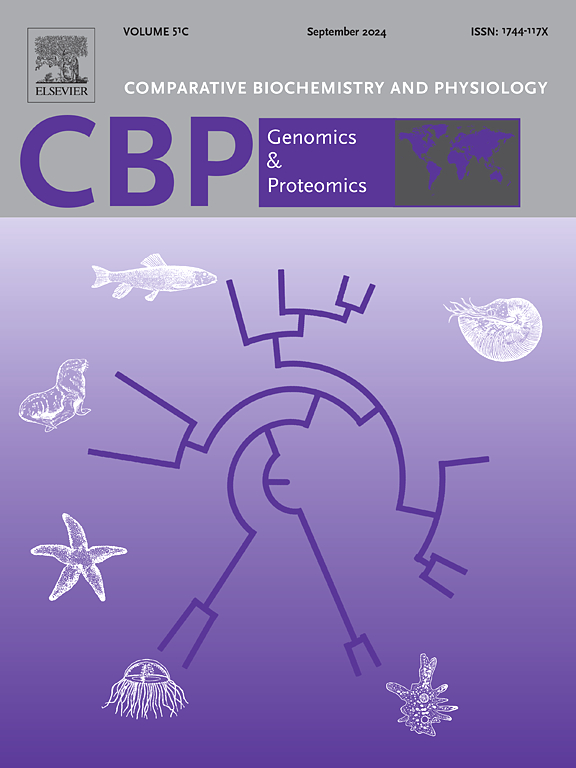多组学揭示了中国长鼻鲶鱼卵巢发育的动态分子特征
IF 2.2
2区 生物学
Q4 BIOCHEMISTRY & MOLECULAR BIOLOGY
Comparative Biochemistry and Physiology D-Genomics & Proteomics
Pub Date : 2025-06-02
DOI:10.1016/j.cbd.2025.101551
引用次数: 0
摘要
长尾鲤(Leiocassis longirostris)是中国重要的淡水鱼种。由于自然种群数量的减少,其市场需求目前主要通过人工繁殖来满足。然而,复杂而漫长的卵巢成熟过程使目前的人工育种方法受到限制。此外,L. longirostris卵巢发育的分子机制仍然知之甚少。在这项研究中,我们对长乳杆菌的卵巢样本进行了5个发育阶段的RNA和蛋白质测序,并根据组织学染色结果进行了分类。为了揭示卵巢发育的动态特征,我们通过分阶段比较基因和蛋白质的表达谱(I至II期、II至III期、III至IV期和IV至V期),鉴定了差异表达基因(DEGs)和差异表达蛋白(DEPs)。GO和KEGG富集分析显示,与内分泌系统、信号转导和脂质代谢相关的条件和途径显著富集,并在各个阶段观察到动态变化。九象限分析进一步阐明了deg和dep的调控特征,突出了参与脂肪和蛋白质消化吸收的基因和蛋白质的mRNA和蛋白质水平调控的差异。从共享的DEGs和DEPs谱进一步构建蛋白相互作用网络,以疏散参与长乳杆菌卵巢发育的候选蛋白。此外,我们根据deg和dep的表达趋势将其聚类为10个簇。聚类的KEGG富集分析显示,FoxO和MAPK信号通路等信号通路在聚类4中显著富集,随着卵巢发育而表达增加。qPCR验证证实了与卵母细胞减数分裂和类固醇激素生物合成相关基因的差异表达,与RNA-seq结果一致。本研究为了解卵巢发育过程中卵黄脂代谢、旁分泌因子和内分泌系统调节提供了基础,并为制定高效的长乳乳鸡人工育种策略提供了参考。本文章由计算机程序翻译,如有差异,请以英文原文为准。

Multi-omics reveals dynamic molecular characteristics in the ovarian development of Chinese longsnout catfish Leiocassis longirostris
Leiocassis longirostris (L. longirostris) is a significant freshwater fish species in China. Due to the decline in natural populations, its market demand is now largely met through artificial breeding. However, the complex and prolonged ovarian maturation process has rendered current artificial breeding methods limited. Additionally, the molecular mechanisms underlying ovarian development in L. longirostris remain poorly understood. In this study, we conducted RNA and protein sequencing of L. longirostris ovarian samples across five developmental stages, categorized based on histological staining results. To uncover the dynamic characteristics of ovarian development, we identified differentially expressed genes (DEGs) and differentially expressed proteins (DEPs) by comparing gene and protein expression profiles stage-by-stage (stage I to II, II to III, III to IV, and IV to V). GO and KEGG enrichment analyses of these profiles revealed significant enrichment in terms and pathways related to the endocrine system, signal transduction, and lipid metabolism, with dynamic changes observed across stages. The nine-quadrant analysis further elucidated the regulatory characteristics of DEGs and DEPs, highlighting differences in mRNA and protein-level regulation of genes and proteins involved in fat and protein digestion and absorption. Protein-protein interaction networks were further constructed from shared DEGs and DEPs profiles to evacuate candidate proteins involved in L. longirostris ovarian development. Moreover, we clustered DEGs and DEPs into ten clusters based on their expression trend. KEGG enrichment analysis of clusters showed pathways such as FoxO and MAPK signaling pathways were significantly enriched in cluster 4, where the expression increased as ovarian development. qPCR validation confirmed differential expression of genes associated with oocyte meiosis and steroid hormone biosynthesis, consistent with RNA-seq results. This study provides a foundation for understanding yolk lipids metabolism, paracrine factors, and endocrine system regulation during ovarian development and offers insights into developing efficient artificial breeding strategies for L. longirostris.
求助全文
通过发布文献求助,成功后即可免费获取论文全文。
去求助
来源期刊
CiteScore
5.10
自引率
3.30%
发文量
69
审稿时长
33 days
期刊介绍:
Comparative Biochemistry & Physiology (CBP) publishes papers in comparative, environmental and evolutionary physiology.
Part D: Genomics and Proteomics (CBPD), focuses on “omics” approaches to physiology, including comparative and functional genomics, metagenomics, transcriptomics, proteomics, metabolomics, and lipidomics. Most studies employ “omics” and/or system biology to test specific hypotheses about molecular and biochemical mechanisms underlying physiological responses to the environment. We encourage papers that address fundamental questions in comparative physiology and biochemistry rather than studies with a focus that is purely technical, methodological or descriptive in nature.

 求助内容:
求助内容: 应助结果提醒方式:
应助结果提醒方式:


